Related Research Articles
Bentley Motors Limited is a British designer, manufacturer and marketer of luxury cars and SUVs. Headquartered in Crewe, England, the company was founded by W. O. Bentley (1888–1971) in 1919 in Cricklewood, North London, and became widely known for winning the 24 Hours of Le Mans in 1924, 1927, 1928, 1929, 1930 and 2003. Bentley has been a subsidiary of the Volkswagen Group since 1998 and consolidated under VW's premium brand arm Audi since 2022.
The British Expeditionary Force (BEF) was the six divisions the British Army sent to the Western Front during the First World War. Planning for a British Expeditionary Force began with the 1906–1912 Haldane Reforms of the British Army carried out by the Secretary of State for War Richard Haldane following the Second Boer War (1899–1902).

Field Marshal John Denton Pinkstone French, 1st Earl of Ypres,, known as Sir John French from 1901 to 1916, and as The Viscount French between 1916 and 1922, was a senior British Army officer. Born in Kent, he saw brief service as a midshipman in the Royal Navy, before becoming a cavalry officer. He achieved rapid promotion and distinguished himself on the Gordon Relief Expedition. He became a national hero during the Second Boer War. He commanded I Corps at Aldershot, then served as Inspector-General of the Army, before becoming Chief of the Imperial General Staff in 1912. He helped to prepare the British Army for a possible European war, and was among those who insisted that cavalry still be trained to charge with sabre and lance. During the Curragh incident he had to resign as CIGS after promising Hubert Gough in writing that the Army would not be used to coerce Ulster Protestants into a Home Rule Ireland.
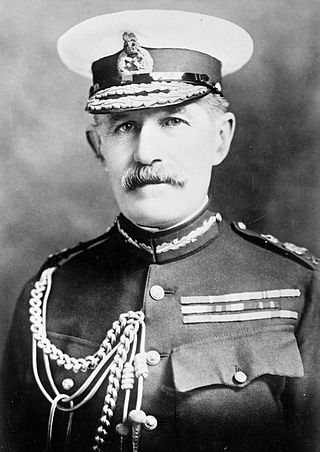
General Sir Horace Lockwood Smith-Dorrien, was a British Army General. One of the few British survivors of the Battle of Isandlwana as a young officer, he also distinguished himself in the Second Boer War.

IV Corps was a corps-sized formation of the British Army, formed in both the First World War and the Second World War. During the First World War the corps served on the Western Front throughout its existence. During the Second World War it served in Norway and Britain until it was transferred to India, which was threatened with attack after Japan entered the war.

Coupé de ville is a car body style produced from 1908 to 1939. It has an external or open-topped driver's position, as well as an enclosed compartment for passengers. Although the different terms may have once had specific meanings for certain car manufacturers or countries, the terms are often used interchangeably.

The First Battle of Ypres was a battle of the First World War, fought on the Western Front around Ypres, in West Flanders, Belgium. The battle was part of the First Battle of Flanders, in which German, French, Belgian armies and the British Expeditionary Force (BEF) fought from Arras in France to Nieuwpoort (Nieuport) on the Belgian coast, from 10 October to mid-November. The battles at Ypres began at the end of the Race to the Sea, reciprocal attempts by the German and Franco-British armies to advance past the northern flank of their opponents. North of Ypres, the fighting continued in the Battle of the Yser (16–31 October), between the German 4th Army, the Belgian army and French marines.

The Battle of Mons was the first major action of the British Expeditionary Force (BEF) in the First World War. It was a subsidiary action of the Battle of the Frontiers, in which the Allies clashed with Germany on the French borders. At Mons, the British Army attempted to hold the line of the Mons–Condé Canal against the advancing German 1st Army. Although the British fought well and inflicted disproportionate casualties on the numerically superior Germans, they were eventually forced to retreat due both to the greater strength of the Germans and the sudden retreat of the French Fifth Army, which exposed the British right flank. Though initially planned as a simple tactical withdrawal and executed in good order, the British retreat from Mons lasted for two weeks and took the BEF to the outskirts of Paris before it counter-attacked in concert with the French, at the Battle of the Marne.

Walter Owen Bentley, was an English engineer who founded Bentley in London. He was a motorcycle and car racer as a young man. After making a name for himself as a designer of aircraft and automobile engines, Bentley established his own firm in 1919. He built the firm into one of the world's premier luxury and performance auto manufacturers, and led the marque to multiple victories at the 24 Hours of Le Mans. After selling his namesake company to Rolls-Royce in 1931, he was employed as a designer for Lagonda, Aston Martin and Armstrong Siddeley.

The Royal Automobile Club is a British private social and athletic club. It has two clubhouses: one in London at 89 Pall Mall, and the other in the countryside at Woodcote Park, near Epsom in Surrey. Both provide accommodation and a range of dining and sporting facilities. The Royal Automobile Club has a wide range of members.
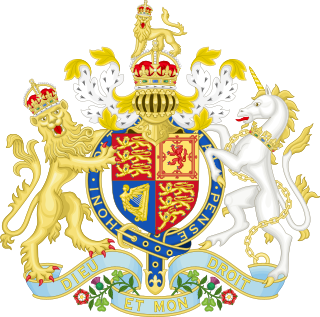
The Motor Car Act 1903 was an Act of the United Kingdom Parliament that received royal assent on 14 August 1903, which introduced motor vehicle registration, driver licensing and increased the speed limit.

Lieutenant-General Sir George Montague Harper,, was a senior officer of the British Army during the First World War.
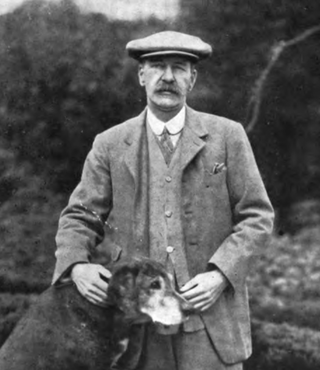
Colonel Sir Alfred "Toby" Rawlinson, 3rd Baronet, was an English soldier and intelligence officer, sportsman, pioneer motorist and aviator.
The 9th Battalion, London Regiment was a Territorial Army infantry battalion of the British Army. The London Regiment was formed in 1908 in order to regiment the various Volunteer Force battalions in the newly formed County of London, and the Queen Victoria's Rifles were one of twenty six units brought together in this way.

The British Army during the First World War fought the largest and most costly war in its long history. Unlike the French and German Armies, the British Army was made up exclusively of volunteers—as opposed to conscripts—at the beginning of the conflict. Furthermore, the British Army was considerably smaller than its French and German counterparts. Photo taken by Ernest Brooks. During the First World War, there were four distinct British armies. The first comprised approximately 247,000 soldiers of the regular army, over half of whom were posted overseas to garrison the British Empire, supported by some 210,000 reserves and a potential 60,000 additional reserves.
This component formed the backbone of the British Expeditionary Force (BEF), which was formed for service in France and became known as the Old Contemptibles. The second army was provided by the approximately 246,000-strong Territorial Force, initially allocated to home defence but used to reinforce the BEF after the regular army suffered heavy losses in the opening battles of the war. The third army was Kitchener's Army, which was composed of men who answered Lord Kitchener's call for volunteers in 1914–1915 and went into action at the Battle of the Somme in 1916. The fourth army was the reinforcement of existing formations with conscripts after the introduction of compulsory service in January 1916.
By the end of 1918, the British Army had reached its maximum strength of 3,820,000 men and could field over 70 divisions. The vast majority of the British Army fought in the main theatre of war on the Western Front in France and Belgium against the German Empire. Some units were engaged in Italy and Salonika against Austria-Hungary and the Bulgarian Army, while other units fought in the Middle East, Africa and Mesopotamia—mainly against the Ottoman Empire—and one battalion fought alongside the Japanese Army in China during the Siege of Tsingtao.
The war also posed problems for the army commanders, given that, prior to 1914, the largest formation any serving General in the BEF had commanded on operations was a division. The expansion of the British Army saw some officers promoted from brigade to corps commander in less than a year. Army commanders also had to cope with the new tactics and weapons that were developed. With the move from manoeuvre to trench warfare, both the infantry and the artillery had to learn how to work together. During an offensive, and when in defence, they learned how to combine forces to defend the front line. Later in the war, when the Machine Gun Corps and the Tank Corps were added to the order of battle, they were also included in the new tactical doctrine.
The men at the front had to struggle with supply problems–there was a shortage of food; and disease was rife in the damp, rat-infested conditions. Along with enemy action, many soldiers had to contend with new diseases: trench foot, trench fever and trench nephritis. When the war ended in November 1918, British Army casualties, as the result of enemy action and disease, were recorded as 673,375 killed and missing, with another 1,643,469 wounded. The rush to demobilise at the end of the conflict substantially decreased the strength of the British Army, from its peak strength of 3,820,000 men in 1918 to 370,000 men by 1920.
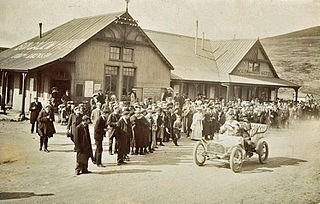
The 1905 International Tourist Trophy was an automobile motor race held on 14 September 1905 on closed public roads along the Highroads Course on the Isle of Man. It was organised by the Automobile Club of Great Britain and Ireland, and was the first time that what became known as the RAC Tourist Trophy was awarded. The race lasted over six hours and was won by John Napier, driving an Arrol-Johnston. Percy Northey finished second in a Rolls-Royce, while the Vinot-Deguingand driver Norman Littlejohn was third.
Claude Goodman Johnson was a British motor vehicle manufacturer who was instrumental in the creation of Rolls-Royce Limited.
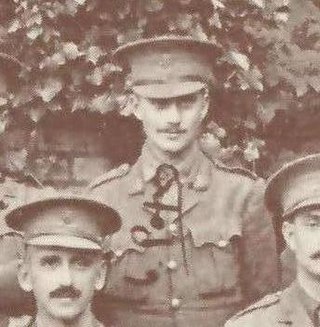
Lieutenant-General Vyvyan Vavasour Pope CBE DSO MC & Bar was a senior British Army officer who was prominent in developing ideas about the use of armour in battle in the interwar years, and who briefly commanded XXX Corps during the Second World War before dying in an air crash.

James Radley (1884–1959) was one of the first English aviators, holding Royal Aero Club Aviators Certificate Number 12. As well as carrying out demonstration flights and competitions in aircraft, he also piloted a ballon in a number of balloon races. As well as his interests in aviation he was a racing driver.
The National Association of Volunteer Motor Transport Corps, commonly known as the Swedish Voluntary Motor Transport(ation) Corps is a Swedish nationwide voluntary organization with the task of further training drivers to ensure the need for heavy vehicles and buses etc in a crisis situation.
References
- ↑ Rawlinson pp. 5-6
- ↑ Rawlinson p. 7
- 1 2 "Royal Automobile Club Volunteer Force 1914". www.westernfrontassociation.com. The Western Front Association. 22 May 2008. Retrieved 7 October 2016.
- ↑ Rawlinson p. 15
- ↑ Coleman p. 60
- ↑ Rawlinson p. 124
- ↑ Rawlinson p. 100
- ↑ Gardner p. 150
- ↑ Smithers pp. 41-43
- ↑ "MotorSport Archive - Page 26, May 1967 - Cars in books". www.motorsportmagazine.com. Motor Sport Magazine. 7 July 2014. Retrieved 8 October 2016.
- ↑ "MotorSport Archive - Page 39, April 1967 - Cars in books". www.motorsportmagazine.com. Motor Sport Magazine. 7 July 2014. Retrieved 8 October 2016.
- 1 2 Baker-Carr p. 14
- ↑ "The Flying Lady". Rolls-Royce Owners' Club. 1951: 114. Retrieved 24 February 2014.
{{cite journal}}: Cite journal requires|journal=(help) - ↑ Coleman p. 25
- ↑ Rawlinson 1925, pp. 80 and 105-106
- ↑ ""Medal Card of Mrs Nora Riddell"" . Retrieved 13 January 2025.
Bibliography
- Baker-Carr, Christopher D'Arcy (1930). From Chauffeur to Brigadier. London: Ernest Benn Ltd.
- Coleman, Frederic. From Mons to Ypres with French: a personal narrative. Toronto: William Briggs.
- Gardner, Nikolas (2003). Trial by Fire: Command and the British Expeditionary Force in 1914. Praeger. ISBN 978-0313324734.
- Messenger, Charles (2005). Call to Arms: The British Army 1914-18. Weidenfeld & Nicolson. ISBN 978-1-7802-2759-7.
- Rawlinson, Alfred (1925). Adventures on the Western Front: August, 1914 - June, 1915. London: Andrew Melrose Ltd.
- Smithers, A J (1992). Cambrai: The First Great Tank Battle. Pen & Sword Books Ltd. ISBN 978-0850522686.